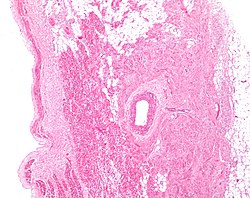Sinoatrial nodal artery
Appearance
| Sinoatrial nodal artery | |
|---|---|
 Low magnification micrograph of a sinoatrial node (central on image), which surroundings the sinuatrial nodal artery (on lumen in the image). H&E stain. | |
 Arteries: RCA = right coronary AB = atrial branches SANB = sinuatrial nodal RMA = right marginal LCA = left coronary CB = circumflex branch LAD/AIB = anterior interventricular LMA = left marginal PIA/PDA = posterior descending MARG = left marginal AVN = atrioventricular nodal Veins: SCV = small cardiac ACV = anterior cardiac AIV/GCV = great cardiac MCV = middle cardiac CS = coronary sinus | |
| Details | |
| Identifiers | |
| Latin | Ramus nodi sinuatrialis arteriae coronariae dextrae |
| TA98 | A12.2.03.104 A12.2.03.212 |
| TA2 | 4133 |
| FMA | 3823 |
| Anatomical terminology | |
The sinuatrial nodal artery (or sinoatrial nodal artery) is an artery of the heart which supplies the sinoatrial node, and arises from the right coronary artery in around 60% of people. In about 40% of cases, the sinoatrial artery is a branch of the left coronary artery or one of its branches. [1] The origin of the sinoatrial node artery is not related to coronary artery dominance. In contrast, the atrioventricular nodal branch is dependent on coronary artery dominance.
Additional images
-
Sternocostal surface of heart (right coronary artery visible at left)
References
- ^ Pejković B, Krajnc I, Anderhuber F, Kosutić D (July 2008). "Anatomical aspects of the arterial blood supply to the sinoatrial and atrioventricular nodes of the human heart". Journal of International Medical Research. 36 (4): 691–8. PMID 18652764.
{{cite journal}}: CS1 maint: multiple names: authors list (link)
External links
- Template:EMedicineDictionary
- . GPnotebook https://www.gpnotebook.co.uk/simplepage.cfm?ID=1443233852.
{{cite web}}: Missing or empty|title=(help)

